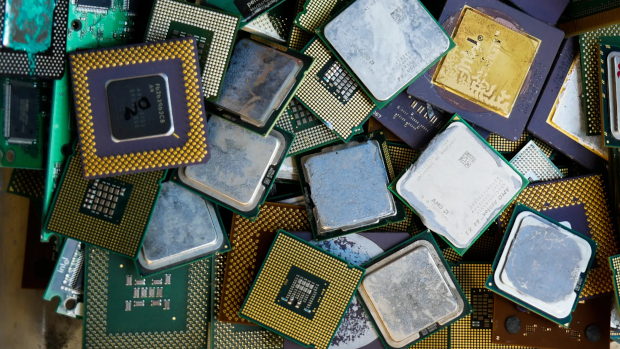
Semiconductor strategy a welcome hint of industrial policy
The Irish government’s recently unveiled semiconductor strategy has outlined a multi-billion euro ambition to significantly expand the sector. Announced this week by the Department of Enterprise, Trade & Employment, the ‘Silicon Island’ strategy (confusingly also referred to as ‘Silicon Ireland’ in the press release), key goals include attracting manufacturers to create up to 14,500 new high-value jobs by 2040, bolstering Ireland’s position within the EU’s goal of achieving 20% of global semiconductor production by 2030.
The plan is to build on existing strengths to attract global giants like TSMC and Samsung, likely through indirect subsidies such as strategically offered land at discounted rates.
Speaking at an industry event, minister for Enterprise, Trade & Employment Peter Burke said the government had set its sights “on the next frontier” and that “with the right support, I believe we could do far more. By 2040, Ireland could support up to 34,500 new semiconductor roles.”
Cynically, one might see hints of ‘plan B’ in the announcement, given uncertainty about the future of Intel, which has major manufacturing facilities in Ireland. Even if this is the case, though, it is still a good idea. Not only would the presence of, say, TSMC give comfort to those concerned Intel’s plan to restructure means job cuts, but it is also be a recognition of the often ignored importance of manufacturing and, indeed, the hard material reality behind seemingly ‘weightless’ technology.
Thinking strategically
Of course, giant as Intel is, it is not the only game in town, even in Ireland. With over 130 companies in the sector and 20,000 jobs, Ireland already possesses a robust and thriving semiconductor ecosystem, contributing significantly to its €13.5 billion in annual chip-related exports.
In all fairness, the strategy has been in the works for some time. Last year, KPMG said that Ireland needed a national strategy to capitalise on its existing strengths and attract further investment, emphasising the potential to expand into areas like advanced packaging and design, alongside manufacturing.
Interestingly, and wisely, the newly-announced strategy does not focus only on cutting edge chip manufacturing, with so-called ‘deliverables’ not only a foundry for today and tomorrow’s most advanced logic and memory chips but also what has been described as “two trailing-edge foundries,” as well as a packaging facility.
This matters because, despite the ongoing war to reduce node size – a significant factor in Intel’s woes is the difficulty it has had getting acceptable yields at 5 nm and lower – there is an enormous market for chips that would, in the consumer world at least, be considered laughably outdated.
Old chips hang around. The automotive sector, a major market for semiconductors, for example. The average car has an average of between 300 and 1,000 chips, depending on its age, while EVs may have as many as 3,000. Naturally these are not the latest Nvidia GPUs and chips made using older, large nodes serve huge markets. Likewise telecoms equipment, medical devices, industrial control systems… the list is endless.
Margins are slim in semiconductor manufacturing, which is part of the reason many chip companies have dumped manufacturing altogether while some, such as Arm, never manufactured any to begin with. However, automotive, industrial, and embedded systems don’t need cutting-edge chips and given the amortisation of costs and high yields, these markets are actually more stable than the leading-edge race.
The rationale is not exactly hard to understand: older chips are cheap and they work. Indeed, some embedded systems, to this day, use positively antediluvian semiconductors. Even the venerable Zilog Z80, an 8-bit chip from the 1970s, reported as going out of production for its standalone DIP-packaged versions in June 2024 is, in fact, still being produced albeit in a slightly modified form, such as the eZ80 microcontroller.
Truthfully, most ‘old’ chips aren’t quite 1970s-old, but it is nonetheless a vast and critical market segment. Likewise, analogue chips are about as boring as could be imagined, but they are a crucial commodity.
Still, plans to attract manufacturers who use the smallest, most cutting edge nodes are also welcome. Much of the fuss around the strategic value of silicon in recent years, notably the policies (and attendant gobs of subsidy) in the form of the EU Chips Act and US CHIPS & Science Act, has happened because some bright spark finally realised that manufacturing most of the world’s advanced chips on a disputed island in the Pacific may be unwise.
Besides, today’s cutting edge chips are also tomorrow’s high volume ‘boring, old chips’.
My only wish is that we, the public, would more clearly recognise these handouts for what they are, not to object, but simply because, as a matter of principle, government spending should be known about. There is no problem with a transparent industrial policy, but indirect subsidies are subsidies no less than are, say, welfare payments.
The strategy laid out by the government should be welcomed because, although it does appear to have defensive elements, it at least builds on Ireland’s existing strengths. In addition, plans to address the reality of the entire market, rather than just the quantum computing and AI buzzwords, means money should be put to work more on something a little more concrete than just chasing headline of cutting-edge manufacturing.






Subscribers 0
Fans 0
Followers 0
Followers